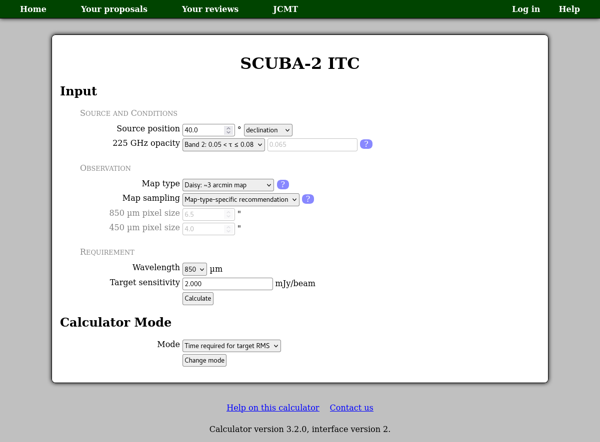SCUBA-2 Integration Time Calculator
This calculator can be used to estimate integration times for SCUBA-2.
Source and Conditions
You can either enter the declination of the source or give an elevation or zenith angle. If you enter the declination then the zenith angle will be estimated as
where 19.823 is the latitude of the JCMT, and the factor 0.9 is an approximation for the average zenith angle of the source.
For the weather conditions you can either select one of the JCMT weather bands, in which case a representative value for that band will be used, or select “Other” and enter a 225 GHz opacity value directly.
Observation
For the map type, select the SCUBA-2 observing mode which you would like to use.
Next select the map sampling scheme for which you wish to perform the calculation. By default, recommended pixel sizes for the selected map type are used. If you plan to use the matched filter, you should select “Matched filter” and the calculator will use sampling factors appropriate for this filter (f850 = 5 and f450 = 8 — please see the SCUBA-2 sensitivity page for more information). Otherwise, if you have specific pixel sizes which you intend to use, you can select “Custom pixel size” and then enter the size to use at each wavelength.
Requirement
The calculator has two modes:
- Time required for RMS
- In this mode you can enter your desired sensitivity (1σ RMS in mJy/beam) and the wavelength. The calculator will estimate the time required to reach this sensitivity and will also show the sensitivity which would be reached in this time at SCUBA-2’s other wavelength.
- RMS expected in given time
- In this mode you can enter the total observing time in hours. The calculator will estimate the sensitivity which would be achieved in each of SCUBA-2’s wavelengths.
You can change calculation mode by selecting the desired mode in the “Calculator Mode” section and pressing the “Change mode” button. The calculator will attempt to adjust your inputs to do the same calculation in the new mode.
